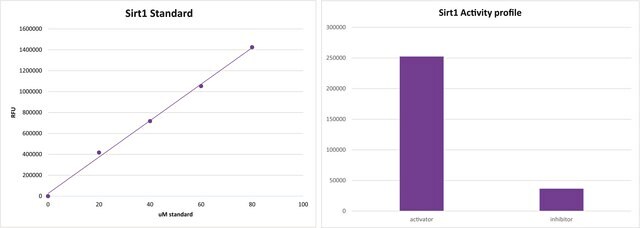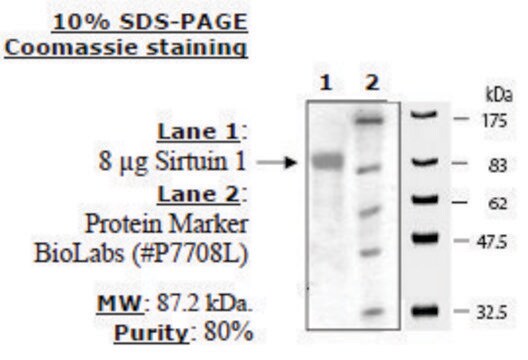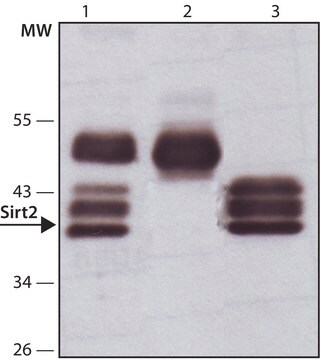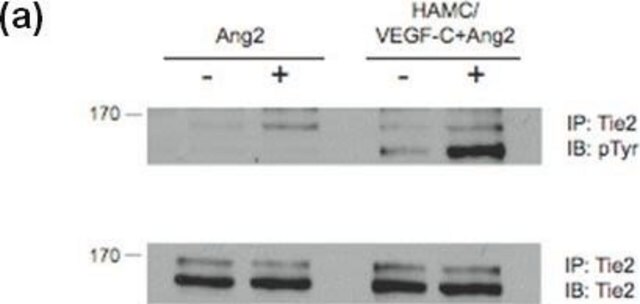S8446
SIRT1 Peptide
≥90% (SDS-PAGE), human recombinant, expressed in E. coli, N-terminal histidine tagged
Sinonimo/i:
SIR2α, SIR2L1, Sirtuin1
Autenticatiper visualizzare i prezzi riservati alla tua organizzazione & contrattuali
About This Item
Prodotti consigliati
Nome del prodotto
Sirt1, recombinant, expressed in E. coli, N-terminal histidine tagged, ≥90% (SDS-PAGE), buffered aqueous glycerol solution
Ricombinante
expressed in E. coli
Livello qualitativo
Descrizione
full-length amino acid sequence of original SIRT1 protein (accession number NP_036370)
Saggio
≥90% (SDS-PAGE)
Stato
buffered aqueous glycerol solution
N° accesso UniProt
Condizioni di spedizione
dry ice
Temperatura di conservazione
−20°C
Informazioni sul gene
human ... SIRT1(23411)
Descrizione generale
SIRT1 (sirtuin 1) belongs to the silent information regulator (SIR) family and is a class of HDAC (histone deacetylase). It is expressed in various tissues including brain, liver, pancreas, adipose tissue, and skeletal muscle. SIRT1 is also known as the longevity gene.
Applicazioni
Human SIRT1 (sirtuin1) has been used in in vitro acetylation and deacetylation assays. It has also been used to study its effects on homeostasis of human nucleus pulposus cells.
Azioni biochim/fisiol
SIRT1 (sirtuin 1) functions as a regulator of various metabolic pathways, and influences the pathophysiology of several metabolic diseases. It is a regulator of protein deacetylation, and is a candidate therapeutic target in non-alcoholic fatty liver disease (NAFLD), amyotrophic lateral sclerosis (ALS), kidney disease, and pulmonary disease. It also participates in tumorigenesis, and whether it functions as an oncogene or as a tumor suppressor depends upon the tumor type. In pancreatic ductal adenocarcinoma (PDAC) its elevated expression is linked with poor prognosis, and in non-small-cell lung cancer (NSCLC) it suppresses the expression of tumor suppressor p27. It is also thought to function as a suppressor of cardiovascular disorders, such as myocardial infarction, or neurodegenerative diseases, such as Alzheimer′s disease (AD) or Parkinson′s disorder (PD).
Sirtuins are a family of NAD+ dependent deacetylases that remove an acetyl group from the e-amino group of lysine residues. The proteins within this family are named after the first protein discovered, from yeast, called Sir2 (Silent Information Regulator 2). The proteins are conserved from bacteria to higher eukaryotes. In humans, there are seven Sir2 family members (SIRT1 to SITR7). SIRT1 plays a pivotal role in the regulation of cellular differentiation, metabolism, cell cycle, apoptosis and regulation of p53. Several targets for SIRT1 were identified among them Lys382 of p53. Using RNA interference, additional targets were identified. It was demonstrated that reduced levels of human SIRT1 led to increased acetylation of Histone H4-Lys16, H4-Lys20, and Histone H3-Lys9 as well as histone H1-Lys26.
Stato fisico
Solution containing 50 mM Tris, pH 7.4, 100 mM NaCl, 1 mM DTT, protease inhibitors (Product code P8340) 1:200, and 10% glycerol (w/v).
Prodotti correlati
N° Catalogo
Descrizione
Determinazione del prezzo
Codice della classe di stoccaggio
12 - Non Combustible Liquids
Classe di pericolosità dell'acqua (WGK)
WGK 1
Punto d’infiammabilità (°F)
Not applicable
Punto d’infiammabilità (°C)
Not applicable
Scegli una delle versioni più recenti:
Possiedi già questo prodotto?
I documenti relativi ai prodotti acquistati recentemente sono disponibili nell’Archivio dei documenti.
Modulations of hMOF autoacetylation by SIRT1 regulate hMOF recruitment and activities on the chromatin
Lu Lu
Cell Research (2011)
Expression of silent mating type information regulator 2 homolog 1 and its role in human intervertebral disc cell homeostasis
Arthritis Research & Therapy (2011)
Yeon-Hwa Lee et al.
Cancer letters, 431, 219-229 (2018-05-29)
SIRT1, an NAD+-dependent histone/protein deacetylase, has diverse physiological actions. Recent studies have demonstrated that SIRT1 is overexpressed in colorectal cancer, suggesting its oncogenic potential. However, the molecular mechanisms by which overexpressed SIRT1 induces the progression of colorectal cancer and its
Taek-Yeol Jung et al.
Experimental & molecular medicine, 52(7), 1075-1089 (2020-07-09)
Histidine triad nucleotide-binding protein 1 (HINT1), which belongs to the evolutionarily conserved HIT superfamily, has been shown to possess a tumor-suppressive function by binding to and inhibiting several oncogenic transcription factors, such as β-catenin and microphthalmia transcription factor (MITF), in
SIRT 1 Overexpression is Associated with Metastasis of Pancreatic Ductal Adenocarcinoma (PDAC) and Promotes Migration and Growth of PDAC Cells.
Li S
Medical Science Monitor : International Medical Journal of Experimental and Clinical Research, 22 (2016)
Il team dei nostri ricercatori vanta grande esperienza in tutte le aree della ricerca quali Life Science, scienza dei materiali, sintesi chimica, cromatografia, discipline analitiche, ecc..
Contatta l'Assistenza Tecnica.








